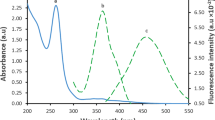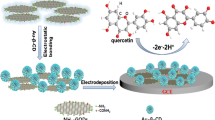Abstract
A gold nanoparticle/graphene quantum dots (AuNP/GQD) nanozyme–modified screen-printed carbon electrode (SPCE) was developed for fast and ultrasensitive determination of quercetin by square-wave voltammetry. The nanosensing device was inserted in miniaturized equipment. Under the optimal experimental conditions, a good linear relationship between oxidation peak current and concentration of quercetin within a very wide range of 1.0 × 10−10 to 1.0 × 10−3 mol L−1 was obtained, with a very low limit of detection of 3.3 × 10−11 mol L−1. To prove the performance of the method, the reproducibility was evaluated and the RSD values were lower than 5.3% and 5.1% for the intra-day and inter-day measurements, respectively. The method was applied to the sensitive determination of quercetin in human plasma droplets with recovery rates of 92.6 to 101.7%.
Graphical abstract








Similar content being viewed by others
References
Boots AW, Haenen GRMM, Bast A (2008) Health effects of quercetin: from antioxidant to nutraceutical. Eur J Pharmacol 585:325–337. https://doi.org/10.1016/j.ejphar.2008.03.008
Andres S, Pevny S, Ziegenhagen R, Bakhiya N, Schäfer B, Hirsch-Ernst KI, Lampen A (2018) Safety aspects of the use of quercetin as a dietary supplement. Mol Nutr Food Res 62:1700447. https://doi.org/10.1002/mnfr.201700447
Hollman PCH, Gaag MVD, Mengelers MJB et al (1996) Absorption and disposition kinetics of the dietary antioxidant quercetin in man. Free Radic Biol Med 21:703–707. https://doi.org/10.1016/0891-5849(96)00129-3
Mervish NA, Gardiner EW, Galvez MP, Kushi LH, Windham GC, Biro FM, Pinney SM, Rybak ME, Teitelbaum SL, Wolff MS, BCERP (2013) Dietary flavonol intake is associated with age of puberty in a longitudinal cohort of girls. Nutr Res 33:534–542. https://doi.org/10.1016/j.nutres.2013.04.005
Tian L, Wang B, Chen R, Gao Y, Chen Y, Li T (2014) Determination of quercetin using a photo-electrochemical sensor modified with titanium dioxide and a platinum(II)-porphyrin complex. Microchim Acta 182:687–693. https://doi.org/10.1007/s00604-014-1374-7
Zhu QG, Sujari ANA, Ab Ghani S (2013) Nafion-MWCNT composite modified graphite paste for the analysis of quercetin in fruits of Acanthopanax sessiliflorus. Sensors Actuators B Chem 177:103–110. https://doi.org/10.1016/j.snb.2012.10.112
Fu Y, Lin Y, Chen T, Wang L (2012) Study on the polyfurfural film modified glassy carbon electrode and its application in polyphenols determination. J Electroanal Chem 687:25–29. https://doi.org/10.1016/j.jelechem.2012.09.040
Zhou Z, Zhao P, Wang C, Yang P, Xie Y, Fei J (2020) Ultra-sensitive amperometric determination of quercetin by using a glassy carbon electrode modified with a nanocomposite prepared from aminated graphene quantum dots, thiolated β-cyclodextrin and gold nanoparticles. Microchim Acta 187:1–9. https://doi.org/10.1007/s00604-019-4106-1
Zheng Y, Ye L, Yan L, Gao Y (2014) The electrochemical behavior and determination of quercetin in choline chloride/urea deep eutectic solvent electrolyte based on abrasively immobilized multi-wall carbon nanotubes modified electrode. Int J Electrochem Sci 9:238–248
Sun S, Zhang M, Li Y, He X (2013) A molecularly imprinted polymer with incorporated Graphene oxide for electrochemical determination of quercetin. Sensors (Switzerland) 13:5493–5506. https://doi.org/10.3390/s130505493
Jin GP, He JB, Rui ZB, Meng FS (2006) Electrochemical behavior and adsorptive stripping voltammetric determination of quercetin at multi-wall carbon nanotubes-modified paraffin-impregnated graphite disk electrode. Electrochim Acta 51:4341–4346. https://doi.org/10.1016/j.electacta.2005.12.011
Chen X, Li Q, Yu S, Lin B, Wu K (2012) Activated silica gel based carbon paste electrodes exhibit signal enhancement for quercetin. Electrochim Acta 81:106–111. https://doi.org/10.1016/j.electacta.2012.07.063
Piovesan JV, Spinelli A (2014) Determination of quercetin in a pharmaceutical sample by square-wave voltammetry using a poly(vinylpyrrolidone)-modified carbon-paste electrode. J Braz Chem Soc 25:517–525. https://doi.org/10.5935/0103-5053.20140019
Li J, Qu J, Yang R, Qu L, de Harrington BP (2016) A sensitive and selective electrochemical sensor based on graphene quantum dot/gold nanoparticle nanocomposite modified electrode for the determination of quercetin in biological samples. Electroanalysis 28:1322–1330. https://doi.org/10.1002/elan.201500490
Yao YY, Zhang L, Wang ZF, Xu JK, Wen YP (2014) Electrochemical determination of quercetin by self-assembled platinum nanoparticles/poly(hydroxymethylated-3,4-ethylenedioxylthiophene) nanocomposite modified glassy carbon electrode. Chin Chem Lett 25:505–510. https://doi.org/10.1016/j.cclet.2014.01.028
Veerapandian M, Seo YT, Yun K, Lee MH (2014) Graphene oxide functionalized with silver@silica-polyethylene glycol hybrid nanoparticles for direct electrochemical detection of quercetin. Biosens Bioelectron 58:200–204. https://doi.org/10.1016/j.bios.2014.02.062
Yola ML, Gupta VK, Eren T, Şen AE, Atar N (2014) A novel electro analytical nanosensor based on graphene oxide/silver nanoparticles for simultaneous determination of quercetin and morin. Electrochim Acta 120:204–211. https://doi.org/10.1016/j.electacta.2013.12.086
Yola ML, Atar N (2014) A novel voltammetric sensor based on gold nanoparticles involved in p-aminothiophenol functionalized multi-walled carbon nanotubes: application to the simultaneous determination of quercetin and rutin. Electrochim Acta 119:24–31. https://doi.org/10.1016/j.electacta.2013.12.028
Mahmudunnabi RG, Farhana FZ, Kashaninejad N, Firoz SH, Shim YB, Shiddiky MJA (2020) Nanozyme-based electrochemical biosensors for disease biomarker detection. Analyst 145:4398–4420. https://doi.org/10.1039/d0an00558d
Yola ML, Atar N (2018) Phenylethanolamine a (PEA) imprinted polymer on carbon nitride nanotubes/graphene quantum dots/core-shell nanoparticle composite for electrochemical PEA detection in urine sample. J Electrochem Soc 165:H1–H9. https://doi.org/10.1149/2.0651802jes
Yola ML, Atar N (2017) A highly efficient nanomaterial with molecular imprinting polymer: carbon nitride nanotubes decorated with graphene quantum dots for sensitive electrochemical determination of Chlorpyrifos. J Electrochem Soc 164:B223–B229. https://doi.org/10.1149/2.1411706jes
Rao H, Zhao X, Liu X, Zhong J, Zhang Z, Zou P, Jiang Y, Wang X, Wang Y (2018) A novel molecularly imprinted electrochemical sensor based on graphene quantum dots coated on hollow nickel nanospheres with high sensitivity and selectivity for the rapid determination of bisphenol S. Biosens Bioelectron 100:341–347. https://doi.org/10.1016/j.bios.2017.09.016
Hsu WF, Wu TM (2019) Electrochemical sensor based on conductive polyaniline coated hollow tin oxide nanoparticles and nitrogen doped graphene quantum dots for sensitively detecting dopamine. J Mater Sci Mater Electron 30:8449–8456. https://doi.org/10.1007/s10854-019-01165-8
Yola ML (2019) Electrochemical activity enhancement of monodisperse boron nitride quantum dots on graphene oxide: its application for simultaneous detection of organophosphate pesticides in real samples. J Mol Liq 277:50–57. https://doi.org/10.1016/j.molliq.2018.12.084
Penu R, Obreja AC, Patroi D, Diaconu M, Radu GL (2015) Graphene and gold nanoparticles based reagentless biodevice for phenolic endocrine disruptors monitoring. Microchem J 121:130–135. https://doi.org/10.1016/j.microc.2015.03.002
Gugoasa LA, Stefan-van Staden RI, van Staden JF et al (2019) Electrochemical determination of bisphenol a in saliva by a novel three-dimensional (3D) printed gold-reduced graphene oxide (rGO) composite paste electrode. Anal Lett 52:2583–2606. https://doi.org/10.1080/00032719.2019.1620262
Zrinski I, Pungjunun K, Martinez S, Zavašnik J, Stanković D, Kalcher K, Mehmeti E (2020) Evaluation of phenolic antioxidant capacity in beverages based on laccase immobilized on screen-printed carbon electrode modified with graphene nanoplatelets and gold nanoparticles. Microchem J 152:104282. https://doi.org/10.1016/j.microc.2019.104282
Britton HTS, Robinson RA (1931) Universal buffer solutions and the dissociation constant of veronal. J Chem Soc 0:1456–1462. https://doi.org/10.1039/JR9310001456
Tudorache M, Bala C (2007) Biosensors based on screen-printing technology, and their applications in environmental and food analysis. Anal Bioanal Chem 388:565–578. https://doi.org/10.1007/s00216-007-1293-0
Tang J, Huang R, Zheng S, Jiang S, Yu H, Li Z, Wang J (2019) A sensitive and selective electrochemical sensor based on graphene quantum dots/gold nanoparticles nanocomposite modified electrode for the determination of luteolin in peanut hulls. Microchem J 145:899–907. https://doi.org/10.1016/j.microc.2018.12.006
Nkosi D, Pillay J, Ozoemena KI, Nouneh K, Oyama M (2010) Heterogeneous electron transfer kinetics and electrocatalytic behaviour of mixed self-assembled ferrocenes and SWCNT layers. Phys Chem Chem Phys 12:604–613. https://doi.org/10.1039/b918754e
Piero Z (2003) Inorganic electrochemistry theory. Royal Society of Chemistry, Practice and Application. https://doi.org/10.1039/9781847551146
Kalyanaraman B, Premovic PI, Sealy RC (1987) Semiquinone anion radicals from addition of amino acids, peptides, and proteins to quinones derived from oxidation of catechols and catecholamines. An ESR spin stabilization study. J Biol Chem 262:11080–11087
Jørgensen LV, Cornett C, Justesen U, Skibsted LH, Dragsted LO (1998) Two-electron electrochemical oxidation of quercetin and kaempferol changes only the flavonoid C-ring. Free Radic Res 29:339–350. https://doi.org/10.1080/10715769800300381
Acknowledgments
The authors are grateful to Dr. Ludmila Aricov for performing UV-Vis measurements.
Funding
This work was financially supported by UEFISCDI-CNCS, subordinated to The Ministry for Education and Research (MER), under grant numbers PN-III-P1-1.1-PD-2016-0190 and PN-III-P4-ID-PCE-2016-0050, PN 1916-Advanced Research in Micro/Nano-Electronics, Photonics and Micro/Nanobiosystems for Development of Applications in Intelligent Specialization Areas (MICRO-NANO-SIS PLUS), within PNCDI III.
Author information
Authors and Affiliations
Corresponding author
Ethics declarations
Conflict of interest
The authors declare that they have no conflict of interest.
Additional information
Publisher’s note
Springer Nature remains neutral with regard to jurisdictional claims in published maps and institutional affiliations.
Electronic supplementary material
ESM 1
(DOCX 540 kb)
Rights and permissions
About this article
Cite this article
Stefanov, C., Negut, C.C., Gugoasa, L.A.D. et al. Gold nanoparticle-graphene quantum dots nanozyme for the wide range and sensitive electrochemical determination of quercetin in plasma droplets. Microchim Acta 187, 611 (2020). https://doi.org/10.1007/s00604-020-04587-y
Received:
Accepted:
Published:
DOI: https://doi.org/10.1007/s00604-020-04587-y




